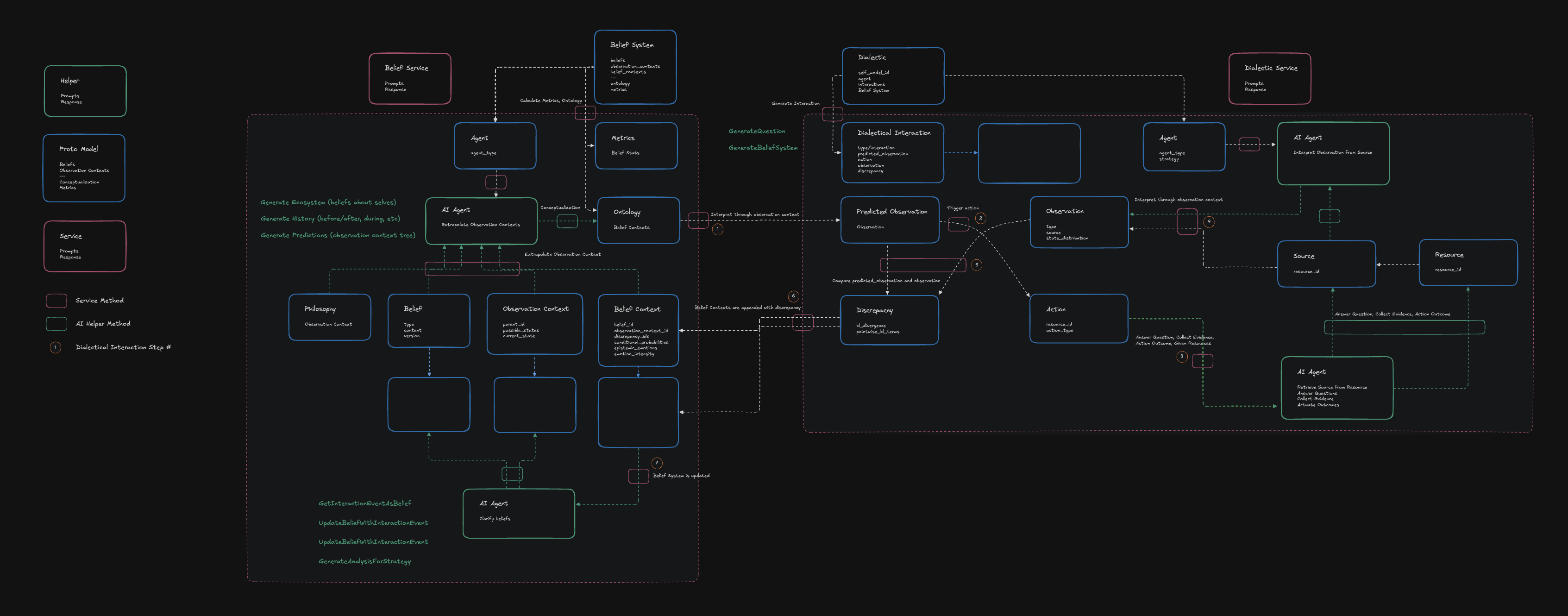Dialectic Model Architecture
The dialectic system in Epistemic Me is designed to facilitate the interaction between AI agents and belief systems through a structured dialogue process. Here’s a detailed breakdown of the architecture:
Core Components
Service Layers
- Belief Service: Manages belief operations and persistence
- Dialectic Service: Handles dialectic interactions and processing
- Helper Service: Provides utility functions and shared operations
AI Agent Integration
The system integrates with AI agents through several key components:- Proto Model: Defines base interaction protocols
- Service: Handles request/response patterns
- AI Agent: Processes dialectic interactions and belief updates
Belief System Components
The belief system consists of several interconnected parts:-
Belief System
- Manages belief states and relationships
- Handles belief context tracking
- Processes belief updates
-
Ontology
- Defines relationships between beliefs
- Maintains belief hierarchies
- Tracks belief context mappings
-
Observation Contexts
- Manages contextual frameworks
- Tracks observation patterns
- Links beliefs to observable phenomena
Dialectic Flow
The dialectic process follows a structured flow:-
Dialectical Interaction
- Initiates with user or system input
- Processes through belief validation
- Generates appropriate responses
-
Predicted Observation
- Uses belief system to generate predictions
- Compares against actual observations
- Updates belief system based on discrepancies
-
Intersubjectivity
- Manages shared understanding between agents
- Processes belief conflicts and resolutions
- Updates shared context models
Implementation Details
Key Processes
-
Belief Update Cycle
GenerateBeliefSystem: Creates initial belief structuresUpdateBeliefSystem: Processes belief modificationsGeneratePredictions: Creates observation-based predictions
-
Dialectic Processing
InitiateDialectic: Starts new dialectic sessionsProcessInteraction: Handles ongoing dialectic flowsUpdateBeliefs: Modifies beliefs based on interactions
-
Observation Handling
GenerateObservation: Creates new observationsCompareObservation: Validates against predictionsUpdateContext: Modifies observation contexts
Integration Points
The system provides several integration points for developers:- Service Methods
- AI Agent Integration
Best Practices
When implementing the dialectic model:-
Belief System Management
- Maintain atomic belief updates
- Track belief provenance
- Handle belief conflicts gracefully
-
Dialectic Processing
- Implement proper error handling
- Maintain interaction context
- Track belief update history
-
Observation Handling
- Validate observations against predictions
- Track observation context changes
- Handle observation conflicts

